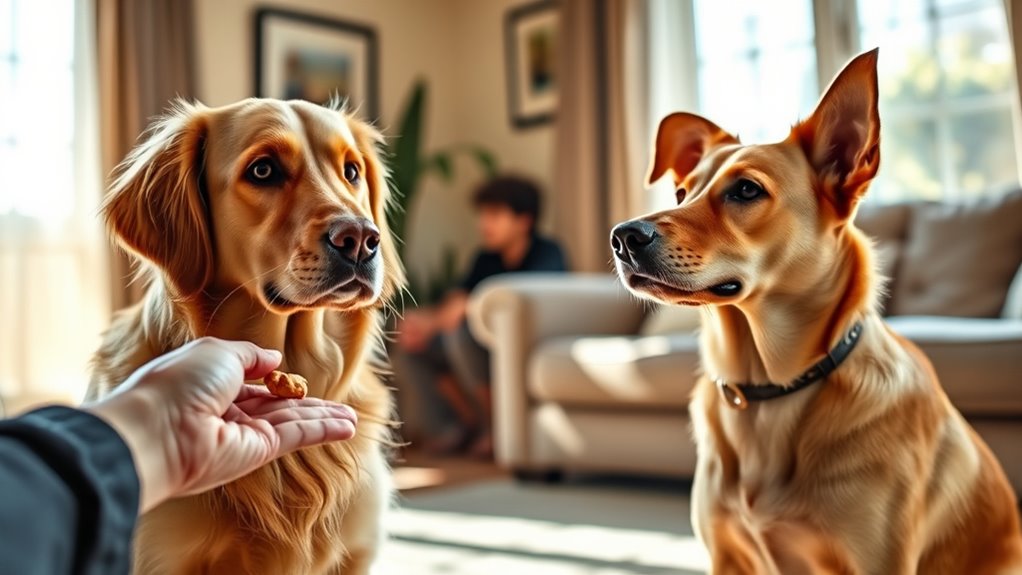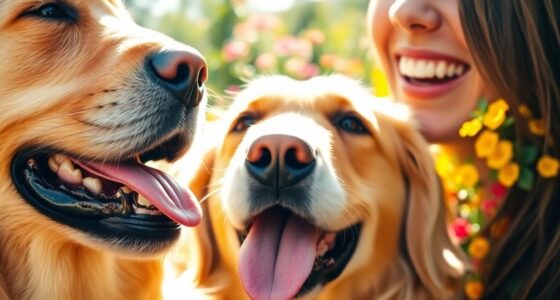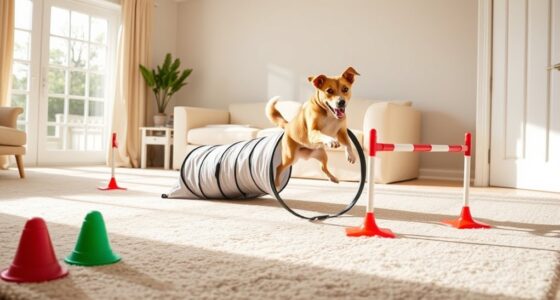Dogs learn through observation by carefully watching their environment, including your actions, body language, and tone of voice. They pay attention to social cues and behaviors of other dogs and humans, often imitating successful actions that lead to positive outcomes. This natural learning process helps them understand commands and behaviors without constant repetition. If you want to see how their observational skills can improve their training, keep exploring these fascinating canine abilities.
Key Takeaways
- Dogs interpret social cues, body language, and tone of voice to understand and imitate behaviors they observe.
- Observation accelerates learning by allowing dogs to associate actions with positive outcomes without constant repetition.
- Dogs watch other animals and humans during training, learning behaviors through visual and contextual cues.
- Group training environments enhance observational learning as dogs observe peers’ responses and reactions.
- Consistent signals and positive reinforcement strengthen a dog’s ability to learn behaviors through observation.

Have you ever wondered how dogs pick up new commands or behaviors so quickly? It’s fascinating to think about, but the answer lies in their remarkable ability to learn through observation. When you engage in dog training, you’re not just teaching commands through repetition; you’re tapping into their natural capacity for canine cognition—the mental processes that allow them to interpret, remember, and imitate. Dogs are inherently social animals, and their brains are wired to pick up cues from their environment and from other animals, especially humans. This makes observation a powerful tool in their learning process.
Dogs learn quickly through observation, interpreting cues, and imitating social behaviors naturally.
In real-life situations, your dog watches your actions carefully. If you consistently reward a certain behavior, like sitting or staying, your dog begins to associate the action with positive outcomes. They learn by observing your body language, tone of voice, and even the reactions of other dogs or humans around them. For example, if your dog sees another dog being praised for fetching a toy, they might try to imitate that behavior, hoping to get similar praise. This kind of learning is a reflection of their ability to process social cues and understand cause-and-effect relationships, which are central to canine cognition.
During dog training sessions, observation plays a key role. Your dog isn’t just passively waiting for treats; they’re actively paying attention to your gestures and commands. They observe how you respond to their efforts and adjust their behavior accordingly. This is why consistent cues and clear signals are so effective—they help your dog understand what you want by watching your actions. Over time, they recognize patterns and develop a mental map of which behaviors lead to rewards. This observational learning accelerates their ability to master new commands without needing constant repetition.
Dogs also learn by watching other dogs. In social settings, they observe their peers and pick up on behaviors that seem to lead to positive results. This is why group training classes are so effective—they create an environment where dogs can learn from each other’s actions. Your dog’s ability to observe, interpret, and replicate behaviors is a testament to their complex canine cognition. It’s not just about obedience; it’s about understanding social dynamics and navigating their environment intelligently.
Understanding how dogs learn through observation can help you become a better trainer. By creating clear, consistent cues and providing positive reinforcement, you tap into their natural learning style. Remember, your dog’s ability to observe and imitate is one of their greatest strengths, making training a rewarding experience for both of you. Additionally, knowing that dogs can learn through canine cognition highlights the importance of patience and positive interactions in the training process.
Frequently Asked Questions
Can Dogs Learn Complex Tasks Solely Through Observation?
Yes, dogs can learn complex tasks through observation, especially if they have strong visual learning and imitation skills. When you demonstrate a behavior clearly, your dog observes your actions and mimics them, gradually mastering the task. Repetition and consistency strengthen this process, making it easier for your dog to understand and replicate behaviors. Keep patient, use positive reinforcement, and your dog will learn through keen observation and imitation skills.
How Does a Dog’s Environment Influence Its Observational Learning?
Your dog’s environment critically influences its observational learning by providing social cues and opportunities for environmental enrichment. When your dog observes others in stimulating settings, it picks up behaviors more effectively. A rich environment with diverse sights, sounds, and interactions helps your pup learn new skills faster. Social cues from humans or other animals guide its understanding, making a supportive environment essential for maximizing your dog’s ability to learn through observation.
Do Puppies Learn Faster by Watching Older Dogs?
Yes, puppies learn faster by watching older dogs because puppy imitation is strong during early socialization. When you expose your pup to experienced dogs, they observe and mimic behaviors, speeding up their learning process. This early socialization helps your puppy grasp commands and social cues quickly, building confidence and reducing future behavioral issues. Consistent positive interactions with older dogs enhance their observational learning, making training more effective and enjoyable.
Can Dogs Learn From Human Actions as Well as Other Dogs?
Think of your dog as a sponge soaking up every ripple of your actions. Yes, dogs can learn from human actions as well as other dogs. They pick up on dog body language and interpret human cues through human-dog communication. By observing your gestures, tone, and behavior, your dog understands commands, boundaries, and emotions, making your interactions a powerful tool for training and bonding.
What Role Does Reinforcement Play in Observational Learning for Dogs?
Reinforcement plays a vital role in your dog’s observational learning by strengthening the connection between behavioral cues and desired actions. When your dog observes you or another dog succeed, timely reinforcement, like treats or praise, encourages them to imitate that behavior. Proper reinforcement timing is essential; if delayed, your dog may not associate the reward with the behavior, reducing effective learning. Consistent reinforcement helps your dog understand what behaviors you expect.
Conclusion
Now, picture your dog watching you intently, eyes locked onto your every move as if they’re soaking in a silent lesson. Through observation, they pick up on your cues, your tone, and your actions, turning them into their own routines. Just like a child learning a new game, your furry friend is constantly observing, absorbing, and adapting. With patience and consistency, you’re guiding their learning journey—watch as they grow more confident and connected with each passing day.










